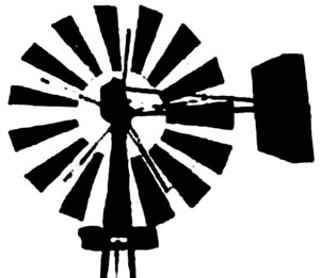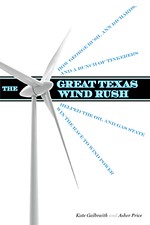PUC Gathering the Western Wind
A new source for electricity is on the wind
By Daniel Mottola, Fri., Aug. 1, 2008

In July, the Public Utility Commission of Texas approved a plan to build nearly 5 billion dollars' worth of power lines to carry wind-generated electricity from West Texas' booming wind farms to the state's major cities, including Austin. The decision will boost Texas' standing as the nation's No. 1 wind-producing state, while supplying enough new energy to power roughly 4.6 million homes. Advocates say the plan could cut statewide electric bills, create in excess of 8,000 new jobs, and even serve future West Texas solar farms. But the decision over just how much line capacity to approve wasn't without turbulence. Some observers cast the debate as a showdown between status-quo fossil-fuel forces protecting their turf and a large contingent of investors struggling to bring something new and clean to the market. In the end, the PUC chose a compromise plan that will vastly boost the state's wind capacity. But many believe regulators missed a rare opportunity by not picking the most ambitious power line build-out, which was favored by greens, lawmakers, and major investors alike.
The number of wind farms built over the past several years has grown rapidly, causing a transmission bottleneck out west, thereby leaving available wind power underutilized. Senate Bill 20, passed in 2005, directed regulators to lay the groundwork for new wind-facilitating power lines. During the subsequent deliberations, everyone from utilities to oil and gas companies to billionaire investors weighed in. Three proposals emerged, with the first, Scenario 1, adding 5,150 megawatts to the grid at a cost of $3.8 billion and the last and most ambitious, Scenario 3, adding 17,956 MW at a cost of $6.4 billion (see chart). Forty-nine state legislators, including 19 GOP lawmakers known as the Conservative Coalition, formally favored the most ambitious scenario. But the PUC – which is made up of all Gov. Perry appointees – approved the middle-of-the-road option, Scenario 2, by a 2-1 vote. "This decision was a compromise, but it's still a huge step forward," said Austin-based energy consultant and wind expert Mike Sloan. "On the other hand, established coal and natural gas interests should feel fortunate that Texas is delaying an additional 6,400 megawatts of new wind power ... as part of Scenario 3 – enough power to produce about twice as much electricity as the entire city of Austin currently uses."
City-owned utility Austin Energy is known for its green initiatives yet initially backed Scenario 1, which would add to the grid less than half the amount of power as the middle scenario and decrease smog and CO2 by an underwhelming 4%. The utility eventually supported Scenario 2 but stopped short of supporting No. 3 because of uncertainty about where the future concentrations of wind farms will be and how many will be needed in the future. "We do not take Scenario 2 to be a midrange or moderate build-out. It includes over 2,300 miles of new high-voltage transmission, will cost $5 billion ... and will allow the amount of wind power from West Texas to more than triple," said Mark Dreyfus, Austin Energy's director of regional and government affairs. By 2014, the expected completion date for the build-out, he said, "We'll have a better idea of where people have developed wind farms, what the new challenges in the transmission grid are, and what the next stage should be."
"Austin Energy has some great people and does many good things," commented Sloan. "However, coal remains Austin Energy's number one fuel source. For renewable energy and for the environment, it will be a happy day when Austin is no longer in the coal business."
The parties that favored Scenario 1, calling it the more "measured" approach, include companies such as ExxonMobil, Chevron, ConocoPhillips, Halliburton, and Luminant (formerly TXU), which profit from coal or natural-gas-generated energy. Their arguments cited wind's intermittence, its inability to be scaled up when needed, and its tendency to diminish around hot afternoon energy-demand peaks. But the Electric Reliability Council of Texas, which oversees the state's power grid, said that power supplies would remain reliable even in the most ambitious scenario. Spokeswoman Dottie Roark said ERCOT uses a sophisticated new wind forecasting tool and will contract with existing power plants (typically natural gas) to remain ready to mitigate wind drop-offs during high demand. During the July proceedings, PUC Commissioner Paul Hudson questioned the "cautionary tone" of Scenario 1's fossil-fuel-friendly supporters, saying, "Aren't you asking us to constrain the market by virtue of asking us to constrain transmission development?" His comments pointed to the irony of their position, suddenly favoring the kind of constraints energy producers and refiners have long blamed for high prices. Meanwhile, diversifying oil companies BP and Shell formally broke ranks with their petro-competitors and threw their support behind the most ambitious scenarios. Both co-own wind projects and are planning new ones.
Private investors, including billionaires T. Boone Pickens and Warren Buffett, as well as a list of major utilities, have lined up to fund the upfront cost of the lines. Under state regulations, they're allowed to recoup costs from ratepayers. While most market watchers estimate that the lines will add about $4 to an average electric bill, wind boosters say that in the five or so years it will take for lines to be built and charges to show up on customers' bills, prices for natural gas (which supplies about 40% of the state's energy) are likely to rise. By then, cheap, new wind power should offset the natural gas costs, resulting in net savings for customers (assuming energy retailers pass along some of those savings). At a press conference in support of Scenario 3, state Rep. Mark Strama said, "The benefits of investing in a renewable energy source such as wind power outweigh the costs 3-to-1."
State Sen. Kirk Watson, who joined Strama's call for maximum wind, said: "Every major Texas city has smog and air pollution problems. More wind energy will result in significant improvements in air quality in all metropolitan areas." Watson noted that more wind may also ensure Texas' ability to supply affordable energy, given recent Department of Energy estimates that statewide power costs could rise up to 62% if federal carbon dioxide emissions limits are enacted.
"While we would have preferred the most aggressive scenario, we think the commission did a good job of balancing the need to use more wind to lower fuel costs and to develop ways to assure the grid remains stable to prevent blackouts," said Public Citizen's Tom "Smitty" Smith. "However, dark clouds may be looming on the horizon. The commissioners delayed a decision until the end of the month on whether to give priority on these lines to so-called 'clean' coal and nuclear plants." Smith has called for separate hearings on line prioritization.
Transmission Line Proposals
| New Megawatts Added | Cost (billions) | Est. CO2/NOx (smog) | Reductions* | |
| Scenario 1 | 5,150 | $3.8 | 4% | 4% |
| Scenario 2 | 11,553 | $4.9 | 10% | 9% |
| Scenario 3 | 17,956 | $6.4 | 16% | 13% |
*Source: Public Citizen
Got something to say on the subject? Send a letter to the editor.









